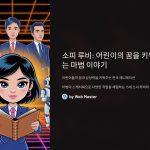
 As children’s media content continues to evolve, there’s a growing demand for programming that not only entertains but also nurtures mental and emotional development. “Sofy Ruby,” a popular South Korean animated series, has recently been spotlighted in child psychology circles for its unique blend of magical storytelling and psychologically enriching narratives. Unlike typical fantasy cartoons, “Sofy Ruby” subtly integrates concepts from developmental psychology—such as empathy, self-awareness, and problem-solving—making it a valuable companion in a child’s formative years. Current educational trends emphasize emotional intelligence (EQ) alongside cognitive skills, and shows like “Sofy Ruby” are perfectly positioned to support this shift. Recent updates in early education curriculum around the globe reflect a greater focus on socio-emotional learning (SEL), which this show intuitively promotes. As digital screen time becomes a staple in childhood, utilizing content like “Sofy Ruby” can be a proactive strategy for parents and educators aiming to merge media consumption with mindful growth.
As children’s media content continues to evolve, there’s a growing demand for programming that not only entertains but also nurtures mental and emotional development. “Sofy Ruby,” a popular South Korean animated series, has recently been spotlighted in child psychology circles for its unique blend of magical storytelling and psychologically enriching narratives. Unlike typical fantasy cartoons, “Sofy Ruby” subtly integrates concepts from developmental psychology—such as empathy, self-awareness, and problem-solving—making it a valuable companion in a child’s formative years. Current educational trends emphasize emotional intelligence (EQ) alongside cognitive skills, and shows like “Sofy Ruby” are perfectly positioned to support this shift. Recent updates in early education curriculum around the globe reflect a greater focus on socio-emotional learning (SEL), which this show intuitively promotes. As digital screen time becomes a staple in childhood, utilizing content like “Sofy Ruby” can be a proactive strategy for parents and educators aiming to merge media consumption with mindful growth.
Sofy Ruby: More Than Just a Magical Girl Story
On the surface, “Sofy Ruby” appears to be a classic magical girl series with glittering transformation scenes and whimsical adventures. But beneath the sparkle lies a thoughtfully crafted world that mirrors real-life emotional challenges children face. The protagonist, Sofy, is not just a princess—she’s also a relatable young girl navigating friendship dilemmas, self-doubt, and the desire to do good. These narrative elements provide subtle yet powerful life lessons, helping young viewers build emotional vocabulary and understand cause-effect dynamics. Episodes often feature problem-solving arcs where characters model resilience and empathy, reinforcing healthy coping strategies. By showing emotional growth as part of character development, the show aligns with key aspects of developmental psychology, making it more than just entertainment—it’s also a gentle guide for emotional intelligence.


Emotional Intelligence and Media: What Children Really Learn
Children learn best through stories and observation. “Sofy Ruby” leverages this by embedding complex emotions—such as jealousy, guilt, forgiveness, and pride—into accessible storylines. These themes are introduced in age-appropriate contexts, allowing children to witness emotional conflict and its resolution within a safe narrative space. Psychological research supports that repeated exposure to such stories can enhance emotional literacy and perspective-taking. For example, when Sofy feels left out or misunderstood, children watching may recognize similar feelings in themselves, allowing them to normalize their emotions and learn positive responses. This resonance builds what psychologists refer to as “emotional mirroring,” an essential step in empathy development. Through repeated patterns, the show encourages children to reflect, self-regulate, and better articulate their inner world—skills foundational to emotional intelligence.

The Psychological Lens: What Makes Sofy Ruby Effective?
From a clinical psychology perspective, “Sofy Ruby” provides a scaffolded model of social learning. The structure of the episodes—introduction, emotional conflict, magical resolution, and reflection—mirrors therapeutic techniques used in child counseling. Characters articulate their thoughts and feelings explicitly, modeling emotional clarity for viewers. The magical elements serve as metaphors for inner transformation, giving children a symbolic language to talk about complex feelings. Moreover, the show’s predictable format offers a sense of emotional safety and continuity, essential for children dealing with uncertainty or anxiety. Psychologists appreciate how the narrative reinforces both intrapersonal and interpersonal skills, helping children feel seen, heard, and understood.

Parent & Educator Perspectives: Real-life Applications
Parents and educators who integrate “Sofy Ruby” into learning or daily routines often observe improvements in children’s emotional expression. Educators can use episodes as discussion prompts in classrooms to talk about emotions or conflict resolution. Meanwhile, parents can co-watch and guide conversations, deepening the child’s self-awareness and bonding through shared experience. For children with social difficulties or emotional sensitivity, the series offers relatable scenarios and language for expressing feelings. By embedding psychological principles in a media format children already enjoy, “Sofy Ruby” serves as a bridge between play and personal development. This aligns perfectly with experiential learning models, where reflection and engagement enhance understanding.
5imz_ Bridging Digital & Real-Life SEL: A Strategy for Today’s Families
In an age where screen time is increasing, transforming it into an opportunity for learning is critical. “Sofy Ruby” can serve as a tool to complement SEL curricula in schools or therapy settings. Combining on-screen lessons with real-world application—like journaling feelings, role-playing scenarios, or drawing reflections—enhances retention and personal connection. It is crucial that adults don’t treat media as passive babysitting but rather engage with it actively. The show’s episodic structure makes it easy to build routines or themes around episodes, whether at home or in classrooms. Leveraging characters children already love, caregivers can craft activities that further emotional insight, reinforcing that emotional intelligence is as vital as academic skills.
6imz_ The Future of Children’s Content: A Psychological Imperative
As the lines between education and entertainment continue to blur, media creators must recognize their role in children’s psychological growth. “Sofy Ruby” represents a gold standard in what children’s programming can achieve when psychological insight and creativity work together. In the future, we can expect more shows to follow suit, embedding SEL and positive psychology into their frameworks. Parents and educators will play a key role in curating and contextualizing these experiences, ensuring that screen time becomes a catalyst for connection, not isolation. As we move toward a media-savvy generation, intentional content like “Sofy Ruby” will be crucial in shaping kinder, more emotionally aware individuals.
*Capturing unauthorized images is prohibited*



